
History of salt in Middlewich
Encyclopedia
Middlewich
, a town in northwest England, lies on the confluence of three rivers – the Dane
, the Croco and the Wheelock
. Most importantly for the history of salt making, it also lies on the site of a prehistoric brine spring.
Following the Roman
invasion, Middlewich was named Salinae on account of the salt deposits around it, as it was one of their major sites of salt production. During this time the Romans built a fort at
Harbutts Field (SJ70216696), to the north of the town
and recent excavations to the south of the fort have found evidence of further Roman activity
including a well and part of a preserved Roman road
.
Salt manufacture has remained the principal industry for the past 2,000 years. Salt making is mentioned in the Domesday book
, and by the 13th century there were approximately 100 "wich
houses" packed around the town's two brine pits. By 1908 there were nine industrial scale salt manufacturers in the town, with a number of open pan salt works close to the canal, however salt manufacture in Middlewich is now concentrated in one manufacturer, British Salt
. The salt is sold as the Saxa
brand by RHM
, and by others e.g. supermarket own brands. Salt produced by British Salt in Middlewich has 57% of the UK market
for salt used in cooking.
, not far from Middlewich, and so to Northwich
. These are very famous Salt-Wiches, five or six miles distant, where brine
or salt water is drawn out of pits, which they pour not upon wood while it burneth as the ancient Gauls
and Germans
were wont to do, but boil it over a fire to make salt thereof. Neither doubt I that these were known unto the Romans, and that from hence was usually paid the Custom of Salt, called Salarium.
"For, there went a notable highway from Middlewich to Northwich, raised with gravel to such a height, that a man may easily acknowledge that it was the work of the Romans, seeing that all this country over, gravel is so scare: and from then at this day it is carried to private men’s uses. Mather Paris writeth that Henry III
stopped up these salt-pits when in hostile manner he wasted this shire; because the Welshmen, so tumultuous in those days should not have any victuals or provisions from thence. But when the fair beams of peace began once more to shine out, they were opened again.
"Then runneth the Dane under Kinderton
, the old seat of the ancient race of the Venebles; who, ever since the first coming of the Normans
have been commonly called the Barons of Kinderton. Beneath this southwards, the little river croco, runnerth also into the Dan…Croke, the river aforesaid being past Brereton, within a little while visiteth Middlewich, very near unto his confluence with Dan, where there be two wells of salt water, parted one from the other by a small brook: Sheathes they call them. The one stands not open, but at certain set times, because folk willingly steal the water thereof, as being of greater virtue and efficacy. From thence runneth Dan to Bostoke, in time past Botestock, the ancient sear of the family of the Bostokes, Knights. Out of this ancient house of the Bostoks, as out of a stock, sprung a goodly number of the same name, in Cheshire, Shropshire, Berkshire and elsewhere."
 The Croxton Works were located on the Trent and Mersey canal, approximately halfway between the Big Lock and the Croxton Lane Bridge at SJ699669. The works were established by the Dairy and Domestic Salt Company, probably in 1892. It was taken over by Henry Seddon before 1905 and worked until closed by subsidence
The Croxton Works were located on the Trent and Mersey canal, approximately halfway between the Big Lock and the Croxton Lane Bridge at SJ699669. The works were established by the Dairy and Domestic Salt Company, probably in 1892. It was taken over by Henry Seddon before 1905 and worked until closed by subsidence
in the 1920s. Until the early 1990s a derelict canal side warehouse still existed on the site, however this has now been demolished. All that remains now is a canal side flash (proposed as the site of a Middlewich
Marina
in the 1970s) and the foundations for the warehouse. Both the flash and warehouse foundations are now overgrown and hardly visible.
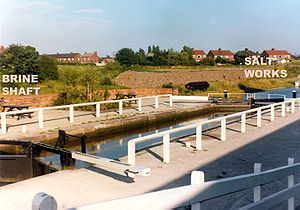 It is likely that this is the only saltworks next to the Roman
It is likely that this is the only saltworks next to the Roman
fort on Harbutt's field.
Salt making sites in Cheshire
places this site at SJ703668, however the
1882 Ordnance Survey map places the salt pans at approximately
SJ7032266605, whilst Middlewich 900–1900 mentions the salt workings being yards away from the stone houses off King Street (i.e. the location given in the 1882 OS map).
It is likely that this was the salt works of the Baron of Kinderton, Peter Venables
, in 1671, and it is listed in documents of 1682 as producing a weekly output of 2,210 bushels of salt from its seven pans. By the mid-eighteenth century this was the only saltworks on the Kinderton
side of the River Croco. In the mid nineteenth century Ralph Seddon owned the works, and on his death it was sold to the Salt Union in 1888. Sometime between 1888 and 1919 the site was dismantled, however a capped off shaft which once formed part of the works could be seen from the path running from King Street to the Big Lock until the new housing estate was built.
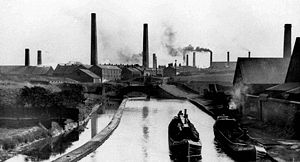 Aman's Salt Works was opened on Brooks Lane shortly after the discovery in 1889 of rock salt and brine at the adjacent Murgatroyd's site, with the earliest entry in the accounts book being the 16 November 1892. The location of Aman's Works, between the Trent and Mersey canal
Aman's Salt Works was opened on Brooks Lane shortly after the discovery in 1889 of rock salt and brine at the adjacent Murgatroyd's site, with the earliest entry in the accounts book being the 16 November 1892. The location of Aman's Works, between the Trent and Mersey canal
and the railway branch line between Sandbach
and Northwich
, is indicative of the move from canals to railways for transport during the nineteenth century. To this end the works had its own siding and platform for loading trains adjacent to the branch line (around 300 metres from Middlewich railway station
).
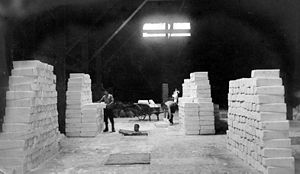
 The only remaining salt works in Middlewich is the British Salt works at Cledford (SJ716644). This salt works obtains its brine from Warmingham
The only remaining salt works in Middlewich is the British Salt works at Cledford (SJ716644). This salt works obtains its brine from Warmingham
nearby, rather than Middlewich.

constructed in the mill town
s of Lancashire
, they would be unsuitable for conversion into other uses. Consequently almost all the structures of the old salt works have been pulled down and the land has been put to other uses.
Middlewich
Middlewich is a market town in the unitary authority of Cheshire East and the ceremonial county of Cheshire, England. It is east of the city of Chester, east of Winsford, southeast of Northwich and northwest of Sandbach....
, a town in northwest England, lies on the confluence of three rivers – the Dane
River Dane
The River Dane is a river mainly in Cheshire in the north west of England.The river rises in Derbyshire, close to the source of the River Goyt just to the south west of Buxton, on Axe Edge Moor...
, the Croco and the Wheelock
River Wheelock
The River Wheelock is a small river in Cheshire in north west England. It drains water from the area between Sandbach and Crewe, and joins the River Dane at Middlewich , and then the combined river flows into the River Weaver in Northwich...
. Most importantly for the history of salt making, it also lies on the site of a prehistoric brine spring.
Following the Roman
Ancient Rome
Ancient Rome was a thriving civilization that grew on the Italian Peninsula as early as the 8th century BC. Located along the Mediterranean Sea and centered on the city of Rome, it expanded to one of the largest empires in the ancient world....
invasion, Middlewich was named Salinae on account of the salt deposits around it, as it was one of their major sites of salt production. During this time the Romans built a fort at
Harbutts Field (SJ70216696), to the north of the town
and recent excavations to the south of the fort have found evidence of further Roman activity
including a well and part of a preserved Roman road
Roman road
The Roman roads were a vital part of the development of the Roman state, from about 500 BC through the expansion during the Roman Republic and the Roman Empire. Roman roads enabled the Romans to move armies and trade goods and to communicate. The Roman road system spanned more than 400,000 km...
.
Salt manufacture has remained the principal industry for the past 2,000 years. Salt making is mentioned in the Domesday book
Domesday Book
Domesday Book , now held at The National Archives, Kew, Richmond upon Thames in South West London, is the record of the great survey of much of England and parts of Wales completed in 1086...
, and by the 13th century there were approximately 100 "wich
WICH
WICH is a radio station licensed to serve Norwich, Connecticut. The station is owned by Hall Communications and licensed to WICH, Inc. It airs a Talk/Nostalgia format....
houses" packed around the town's two brine pits. By 1908 there were nine industrial scale salt manufacturers in the town, with a number of open pan salt works close to the canal, however salt manufacture in Middlewich is now concentrated in one manufacturer, British Salt
British Salt
British Salt Limited is a United Kingdom-based chemical company that produces pure white salt. The company is owned by the management and private equity company LDC...
. The salt is sold as the Saxa
Saxa (food product)
Saxa is a brand of salt and pepper in the United Kingdom and Australia. It is currently owned by Premier Foods....
brand by RHM
RHM
RHM plc, formerly Rank Hovis McDougall, was a United Kingdom food business. The company owned numerous brands, particularly for flour, where its core business started, and for consumer food products...
, and by others e.g. supermarket own brands. Salt produced by British Salt in Middlewich has 57% of the UK market
for salt used in cooking.
Camden's “Magna Brittania”, 1580
"From thence runneth Wever down by NantwichNantwich
Nantwich is a market town and civil parish in the Borough of Cheshire East and the ceremonial county of Cheshire, England. The town gives its name to the parliamentary constituency of Crewe and Nantwich...
, not far from Middlewich, and so to Northwich
Northwich
Northwich is a town and civil parish in the unitary authority of Cheshire West and Chester and the ceremonial county of Cheshire, England. It lies in the heart of the Cheshire Plain, at the confluence of the rivers Weaver and Dane...
. These are very famous Salt-Wiches, five or six miles distant, where brine
Brine
Brine is water, saturated or nearly saturated with salt .Brine is used to preserve vegetables, fruit, fish, and meat, in a process known as brining . Brine is also commonly used to age Halloumi and Feta cheeses, or for pickling foodstuffs, as a means of preserving them...
or salt water is drawn out of pits, which they pour not upon wood while it burneth as the ancient Gauls
Gauls
The Gauls were a Celtic people living in Gaul, the region roughly corresponding to what is now France, Belgium, Switzerland and Northern Italy, from the Iron Age through the Roman period. They mostly spoke the Continental Celtic language called Gaulish....
and Germans
Germans
The Germans are a Germanic ethnic group native to Central Europe. The English term Germans has referred to the German-speaking population of the Holy Roman Empire since the Late Middle Ages....
were wont to do, but boil it over a fire to make salt thereof. Neither doubt I that these were known unto the Romans, and that from hence was usually paid the Custom of Salt, called Salarium.
"For, there went a notable highway from Middlewich to Northwich, raised with gravel to such a height, that a man may easily acknowledge that it was the work of the Romans, seeing that all this country over, gravel is so scare: and from then at this day it is carried to private men’s uses. Mather Paris writeth that Henry III
Henry III of England
Henry III was the son and successor of John as King of England, reigning for 56 years from 1216 until his death. His contemporaries knew him as Henry of Winchester. He was the first child king in England since the reign of Æthelred the Unready...
stopped up these salt-pits when in hostile manner he wasted this shire; because the Welshmen, so tumultuous in those days should not have any victuals or provisions from thence. But when the fair beams of peace began once more to shine out, they were opened again.
"Then runneth the Dane under Kinderton
Kinderton
Kinderton is an electoral ward in Middlewich, Cheshire, England. Kinderton was also historically the name of a township in Middlewich on the opposite side of the River Croco from the current ward....
, the old seat of the ancient race of the Venebles; who, ever since the first coming of the Normans
Normans
The Normans were the people who gave their name to Normandy, a region in northern France. They were descended from Norse Viking conquerors of the territory and the native population of Frankish and Gallo-Roman stock...
have been commonly called the Barons of Kinderton. Beneath this southwards, the little river croco, runnerth also into the Dan…Croke, the river aforesaid being past Brereton, within a little while visiteth Middlewich, very near unto his confluence with Dan, where there be two wells of salt water, parted one from the other by a small brook: Sheathes they call them. The one stands not open, but at certain set times, because folk willingly steal the water thereof, as being of greater virtue and efficacy. From thence runneth Dan to Bostoke, in time past Botestock, the ancient sear of the family of the Bostokes, Knights. Out of this ancient house of the Bostoks, as out of a stock, sprung a goodly number of the same name, in Cheshire, Shropshire, Berkshire and elsewhere."
Croxton Works

Subsidence
Subsidence is the motion of a surface as it shifts downward relative to a datum such as sea-level. The opposite of subsidence is uplift, which results in an increase in elevation...
in the 1920s. Until the early 1990s a derelict canal side warehouse still existed on the site, however this has now been demolished. All that remains now is a canal side flash (proposed as the site of a Middlewich
Middlewich
Middlewich is a market town in the unitary authority of Cheshire East and the ceremonial county of Cheshire, England. It is east of the city of Chester, east of Winsford, southeast of Northwich and northwest of Sandbach....
Marina
Marina
A marina is a dock or basin with moorings and supplies for yachts and small boats.A marina differs from a port in that a marina does not handle large passenger ships or cargo from freighters....
in the 1970s) and the foundations for the warehouse. Both the flash and warehouse foundations are now overgrown and hardly visible.
Kinderton Salt Works

Ancient Rome
Ancient Rome was a thriving civilization that grew on the Italian Peninsula as early as the 8th century BC. Located along the Mediterranean Sea and centered on the city of Rome, it expanded to one of the largest empires in the ancient world....
fort on Harbutt's field.
Salt making sites in Cheshire
places this site at SJ703668, however the
1882 Ordnance Survey map places the salt pans at approximately
SJ7032266605, whilst Middlewich 900–1900 mentions the salt workings being yards away from the stone houses off King Street (i.e. the location given in the 1882 OS map).
It is likely that this was the salt works of the Baron of Kinderton, Peter Venables
Peter Venables
Peter Venables is a British psychologist he is currently Emeritus Professor of Psychology at the University of York. He works in the areas of psychophysiology and the biosocial causes of schizophrenia, schizophrenic spectrum disorders and antisocial behaviour....
, in 1671, and it is listed in documents of 1682 as producing a weekly output of 2,210 bushels of salt from its seven pans. By the mid-eighteenth century this was the only saltworks on the Kinderton
Kinderton
Kinderton is an electoral ward in Middlewich, Cheshire, England. Kinderton was also historically the name of a township in Middlewich on the opposite side of the River Croco from the current ward....
side of the River Croco. In the mid nineteenth century Ralph Seddon owned the works, and on his death it was sold to the Salt Union in 1888. Sometime between 1888 and 1919 the site was dismantled, however a capped off shaft which once formed part of the works could be seen from the path running from King Street to the Big Lock until the new housing estate was built.
Pepper Street Salt Works
In around 1913 the Pepper Street salt works were rebuilt by Henry Seddon. Following a merger between Seddon and Sons and Cerebos in the late 1950s, the open pans at Pepper Street and those at the Cerebos site on Booth Lane were worked together as a single department, before being closed in 1968–1970. The Pepper Street works were demolished in the mid 1970s (at around the same time as the gas works on the opposite side of the canal), and the site is now a housing estate.Wych House Lane Salt Works
In the 14th century the area around the current Wych House Lane was occupied by many salt houses. In 1892 a new salt works was established to the north of Wych House Lane, owned by the Dairy and Domestic Company. In common with many of the works this was taken over by Henry Seddon in the early 1900s. The works continued to be used until around 1969, and were used by the town council as a depot until the 1980s. The land is currently a green field running down to the canal.Chesworth’s/Newtons Salt Works
Salt making sites in Cheshire locates Newtons Salt Works at the same site as Wych House Lane Salt works (SJ705662). However the 1898 map places Newtons Salt Works to the south side of Wych House Lane, at approximately SJ706661.Aman's Salt Works

Canal
Canals are man-made channels for water. There are two types of canal:#Waterways: navigable transportation canals used for carrying ships and boats shipping goods and conveying people, further subdivided into two kinds:...
and the railway branch line between Sandbach
Sandbach
Sandbach is a market town and civil parish in the unitary authority of Cheshire East and the ceremonial county of Cheshire, England. The civil parish contains four settlements; Sandbach itself, Elworth, Ettiley Heath and Wheelock....
and Northwich
Northwich
Northwich is a town and civil parish in the unitary authority of Cheshire West and Chester and the ceremonial county of Cheshire, England. It lies in the heart of the Cheshire Plain, at the confluence of the rivers Weaver and Dane...
, is indicative of the move from canals to railways for transport during the nineteenth century. To this end the works had its own siding and platform for loading trains adjacent to the branch line (around 300 metres from Middlewich railway station
Middlewich railway station
Middlewich railway station served the Cheshire England salt-producing town of Middlewich between 1868 and 1960. It lay on a branch line from Sandbach to Northwich...
).
Murgatroyd's Salt works

British Salt

Warmingham
Warmingham is a village and civil parish in the unitary authority of Cheshire East and the ceremonial county of Cheshire, England. The village lies 3¼ miles to the north of Crewe and 3¼ miles to the west of Sandbach. The parish also includes the settlement of Lane Ends. Nearby villages include...
nearby, rather than Middlewich.

Regeneration
All of the old town centre salt works are now closed. Because of the aggressive chemicals that were handled, salt houses were 'temporary' structures, and so unlike the millsCotton mill
A cotton mill is a factory that houses spinning and weaving machinery. Typically built between 1775 and 1930, mills spun cotton which was an important product during the Industrial Revolution....
constructed in the mill town
Mill town
A mill town, also known as factory town or mill village, is typically a settlement that developed around one or more mills or factories .- United Kingdom:...
s of Lancashire
Lancashire
Lancashire is a non-metropolitan county of historic origin in the North West of England. It takes its name from the city of Lancaster, and is sometimes known as the County of Lancaster. Although Lancaster is still considered to be the county town, Lancashire County Council is based in Preston...
, they would be unsuitable for conversion into other uses. Consequently almost all the structures of the old salt works have been pulled down and the land has been put to other uses.
 |
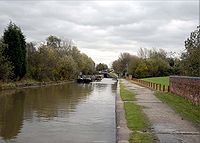 |
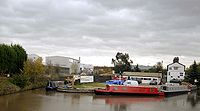 |
|---|---|---|
| Pepper Street | Amans | Brunner Mond |
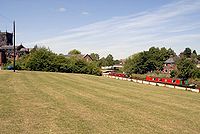 |
||
| Wych House Lane |
| <-1400 | <-1450 | <-1500 | <-1550 | <-1600 | <-1650 | <-1700 | <-1750 | <-1800 | <-1850 | <-1900 | <-1950 | <-2000 | |
|---|---|---|---|---|---|---|---|---|---|---|---|---|---|
| Croxton Salt Works | |||||||||||||
| Kinderton Salt Works | |||||||||||||
| Pepper Street Salt Works | |||||||||||||
| Wych House Lane Salt Works | |||||||||||||
| Amans Salt Works | |||||||||||||
| British Salt | |||||||||||||
See also
- History of saltHistory of saltSalt's ability to preserve food was a foundation of civilization. It eliminated the dependence on the seasonal availability of food and it allowed travel over long distances. However, salt was difficult to obtain, and so it was a highly valued trade item...
- Salt in CheshireSalt in CheshireCheshire is a county in North West England. Rock salt was laid down in this region some 220 million years ago, during the Triassic period. Seawater moved inland from an open sea, creating a chain of shallow salt marshes across what is today the Cheshire basin...
- Open pan salt makingOpen pan salt makingIn Europe virtually all domestic salt is obtained by solution mining of underground salt formations although some is still obtained by the solar evaporation of sea water. Salt is extracted from the Brine using vacuum pans, where brine is heated in a partial vacuum in order to lower the boiling...
- Weaver Hall Museum and WorkhouseSalt Museum, NorthwichThe Weaver Hall Museum and Workhouse, Northwich, Cheshire, records the social, cultural and industrial history of west Cheshire. It was formerly known as the Salt Museum, reflecting its earlier focus on the history of salt extraction, a local industry dating back to Roman times...
, Northwich

